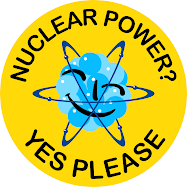In the Sydney Morning Herald article
Partner plan shares benefits - and risks, Mark
Coultan describes the US Sponsored
Global Nuclear Energy Partnership, the related challenges and where Australia fits into the broader equation.
Take a look at the
GNEP website via the link above. This programme is being fast-tracked if ever one was.
From a technical perspective, reprocessing is a very good thing. It reduces amount of waste, the required decay time, and increases the total recoverable energy many times over. But I know Prof.
von Hippel - a wise man indeed, and the simple example he contributed to the article highlights an issue that must be addressed with ample conservatism (and plenty of margin in all regards).
In regional news:
More Market Players Needed if China Is to Meet Nuclear Power Target as reported by Resource Investor. Since trade magazines and the like make their livelihood tracking the flow of capital investments etc. around the world - I put a fair amount of stock in 'following the money'.
Experts are speculating on what China will have to do (break up a current generation monopoly) to facilitate the country's goal of an additional 31,000
MWe of capacity (about 31 large nuclear plants).
Interestingly enough this was being discussed at the "conference on renewable energy" in Beijing. I can barely contain my delight!
"The National Development and Reform Commission's vice director, Chen Demin, recently revealed that the government intends to raise the nation's target to 60,000 megawatts in the future," said Sha Yiqiang, a senior engineer from the China Electricity Council. "The 40,000 megawatt target, which means the addition of at least two 1000-megawatt nuclear generators each year, was already a tough ask," he added. [So this is why they 'really' need to split up the monopoly.]
"China's push to meet such a target though marks a golden opportunity for domestic and foreign companies with sufficient capital and advanced research and development capabilities," Sha explained.
Here's an industry trade news service speaking of nuclear as if it spurs economic and industrial growth... how can this be??? And we hear a lot of Anti-nuclear activists going on about how there's no nuclear expansion - but for China. What do they say about this???
Global competition for uranium will certainly increase in the future as similarly ambitious nuclear power plans are taken up by nuclear powerhouses such as the United States and Russia as well as emerging markets like India. Russia, for example, aims to raise the share of nuclear power in its total electricity generation activities to 25% by 2020 by putting two new reactors into operation each year.
Due to robust demand in the global market and supply disruptions at the two of the world's largest uranium mines, Merrill Lynch & Co. forecast that uranium prices will rise by 78% in 2008. The price of uranium doubled last year and has increased five fold over the last five years.
Yikes! Five fold!?... won't higher uranium prices challenge the industry even further?
"Uranium prices are not such a big deal, as raw materials account for less than 10% of the total cost of nuclear power," Sha said.
The dawn of the millennium seemed to mark the sunset of nuclear power in Europe. The public did not want it. Only two reactors had been built since the Chernobyl disaster of 1986.
Only France, which takes 78 per cent of its electricity from nuclear power, and Finland, which decided to build a fifth reactor in 2002, held out against the ebbing tide.
But the tide may have turned. Four days after the British Prime Minister, Tony Blair, won the 2005 election, having ducked the issue during the campaign, a leaked Downing Street document revealed that nuclear power was back on the table. Last year Blair said openly it was back "with a vengeance".
In January this year the German Chancellor, Angela Merkel, also said the unsayable. "We must think about the consequences of shutting down nuclear power plants," she said, angering her Government partners, the anti-nuclear Social Democrats. "We need a comprehensive, balanced energy mix in Germany."
What happened? First, Europe is alarmed about having to rely on a resurgent and unpredictable Russia, from which it takes a quarter of its gas. Russia's President, Vladmir Putin, sent shockwaves through Europe when Russia's state-controlled energy giant, Gazprom, cut off gas supplies to Ukraine in last year's freezing winter to try to settle a price dispute.
The other change is the belated rise of climate change to the top of the global agenda. Britain's carbon dioxide emissions are growing fast: it will fail to meet its commitment of a 20 per cent cut in greenhouse gas emissions by 2010. What's more, wind power will produce just 7 per cent of electricity by 2010, despite big investments in wind farms. Britain's 14 nuclear power stations, which supply a fifth of all electricity, are ageing. Since they take about 10 years to build, it is time, says Blair, to invest in a new generation of reactors.
In terms of carbon dioxide emissions, the case is strong. British environmentalist George Monbiot, who on balance opposes nuclear power, published figures showing that electricity produced by a pressurised light-water nuclear reactor emitted about 16 tonnes of carbon dioxide per megawatt hour, compared with 356 for gas and 891 for coal.



















